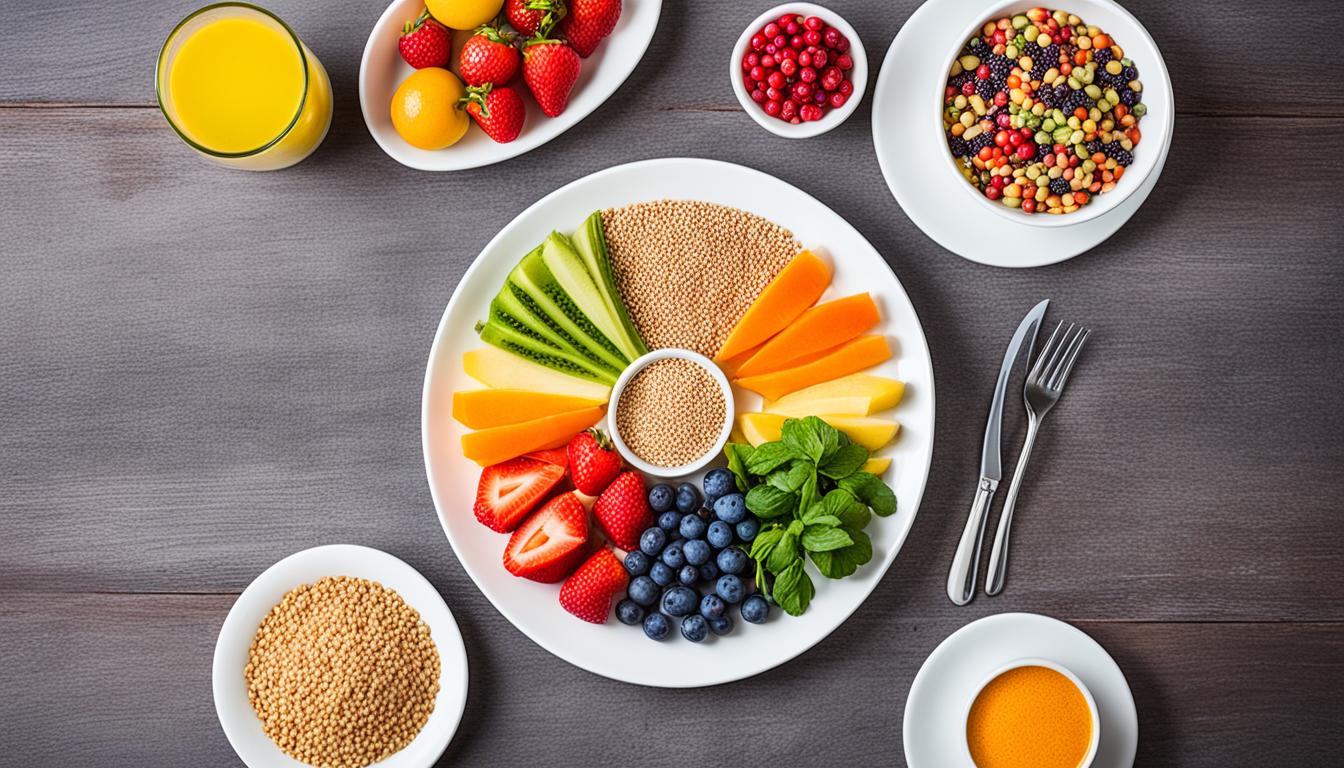One cup of raw cauliflower has more than the daily adult amount of vitamin C. This impressive start hints at its superfood status. Cauliflower comes from the Mediterranean, but it’s now popular everywhere, like its cousins broccoli and Brussels sprouts.
Cauliflower is a powerhouse of vitamins, minerals, and healthy plant compounds. Despite being low in calories, it’s rich in nutrients. This makes it a top choice for health and wellness.
Key Takeaways
- Cauliflower is a nutrient-dense superfood packed with vitamins, minerals, and antioxidants.
- A single cup of raw cauliflower contains more than the daily recommended adult allowance of vitamin C.
- Cauliflower is low in calories, with only 22 calories in a 3 1/2-ounce serving.
- The vegetable is a member of the Brassica family, sharing characteristics with other cruciferous vegetables.
- Cauliflower can support overall health and wellness due to its comprehensive nutritional profile.
Introduction to Cauliflower
Cauliflower comes from the Mediterranean region and has a long history. It dates back to ancient times. Across these centuries, different varieties like white, orange, green, and purple have appeared. Each type looks unique and offers slightly different nutrients. Like broccoli and kale, cauliflower belongs to the cruciferous vegetable family.
Origins and Varieties
Cauliflower started in the Mediterranean and has been grown for thousands of years. It has traveled worldwide and now comes in many types. From the usual white to the colorful orange, green, and purple, each kind offers something special. This visual and nutritional variety makes cauliflower a star.
A Member of the Cruciferous Family
Cauliflower, as a cruciferous veggie, is kin to broccoli, cabbage, and kale. This plant family is famous for being rich in health-boosting compounds, like glucosinolates. These have shown promise in preventing cancer. Their shared tasty flavors and textures make them perfect for a healthy, complete meal.
Cauliflower Nutrition Profile
Macronutrients and Fiber Content
Cauliflower is low in calories, with only 25 per 1 cup of raw florets. It mainly has carbohydrates, 5 grams in a serving, and a fair amount of protein, 2 grams. Its 2 grams of fiber per serving helps you feel full and aids in digestion.
Vitamins and Minerals
Cauliflower is packed with essential vitamins and minerals. It’s high in vitamin C, giving you over half your daily need in one serving. You’ll also get lots of vitamin K, folate, vitamin B6, and potassium. There’s calcium, iron, and magnesium in smaller amounts. This variety makes it a great choice for your overall health.
Antioxidants and Phytochemicals
Cauliflower has many health-boosting plant compounds. It’s loaded with antioxidants like glucosinolates, phenolics, flavonoids, and chlorophyll. These fight free radicals and lower disease risk. Cauliflower’s sulforaphane is known for its anti-inflammatory and cell-protecting benefits.
Couli Flower Nutrition Facts
Nutrient Density and Low Calorie Count
Cauliflower is rich in nutrients but low in calories. It’s a top choice for a nutrient-dense meal. With only 25 calories in one cup, you get lots of vitamins and minerals. This makes it perfect for staying healthy and watching your calorie intake.
Comprehensive Nutrition for Overall Health
Cauliflower packs a selection of nutrients. These include vitamins, minerals, fiber, and antioxidants. It helps keep our immune system strong, our heart healthy, and our digestion smooth.
This vegetable might even lower the risk of some cancers. So, adding cauliflower to your meals is a wise move for your health.
Health Benefits of Cauliflower
Cauliflower has compounds like glucosinolates and isothiocyanates. These are known for their cancer-preventive effects. They work by fighting off cancer-causing elements, reducing stress, and stopping cancer cells from growing and spreading.
Eating cauliflower and other cruciferous vegetables could help lower your cancer risk. This includes cancers that affect the breast, prostate, and colon.
Heart Health and Blood Pressure Regulation
Cauliflower is good for the heart because of its anti-inflammatory properties. It’s rich in vitamin C and antioxidants. This can help fight inflammation, which is a big risk for heart disease.
Also, cauliflower is rich in potassium. This mineral is important for keeping your blood pressure in check. It balances the negative effects of sodium and keeps your blood vessels healthy.
Digestive Health and IBS
Cauliflower is great for your gut health because it’s full of dietary fiber. This fiber keeps you regular and prevents constipation. If you have irritable bowel syndrome (IBS), cauliflower’s fiber can be good for you.
But, if you’re sensitive to certain foods like those high in FODMAPs, be careful with cauliflower. It might make your IBS symptoms worse if you eat a lot of it. So, talk to your doctor before making it a big part of your diet.
Raw vs. Cooked Cauliflower
Having raw cauliflower keeps its nutrients better than cooking. Heat can reduce some of its vitamins and minerals. Eating it raw gives you lots of vitamins C and K. You also get antioxidants that help your health.
Raw cauliflower is very good for you. Plus, it tastes fresh and crunchy.
Preserving Nutrients in Raw Cauliflower
Not all cooking ways are bad for cauliflower’s nutrients. Steaming is the top choice for keeping nutrients. Roasting and sautéing also keep more nutrients than boiling.
When you boil cauliflower, nutrients can end up in the water. This means you might not get all the good stuff. So, pick steaming, roasting, or sautéing if you can.
Cooking Methods and Nutrient Retention
Cooking cauliflower changes its health benefits. The way and time you cook it matters. For example, steaming and boiling reduce antioxidants but boiling does it most. Microwaving is better than boiling for keeping nutrients.
So, if you want the most nutrients, try microwaving. Steaming is okay too. Boiling is the worst for keeping healthy plant compounds.
| Cooking Method | Nutrient Retention |
|---|---|
| Microwaving | Lowest nutrient losses |
| Steaming | Moderate nutrient retention |
| Boiling | Highest impact on nutrient loss |
Eating cauliflower is good for you, cooked or raw. But, how you cook it matters for keeping all the nutrients. Choose simple ways to cook cauliflower to get the most health from it.
Culinary Uses of Cauliflower
Cauliflower is a very flexible food. Its soft flavor and changeable texture mean it works in many dishes. You can eat it raw, cooked, or as a ‘mashed potato’. It fits well in salads, soups, and stir-fries. It’s also good as a base for pizza crusts or rice substitutes. This veggie can pick up any flavor, making it great for all sorts of meals.
Versatile Ingredient in Various Dishes
There’s so much more to do with cauliflower than you might think. You can make cauliflower rice by grating it. This is a healthy, low-carb swap for rice. Or try a cauliflower pizza crust for a lighter pizza. Mixing cauliflower with cheese and eggs makes a tasty base. Roasting it for salads adds crunch, flavor, and nutrients to your greens. Discovering these ideas shows you how flexible cauliflower can be for delicious, healthy food.
Creative Cauliflower Recipes
Cauliflower is like a blank page for creative cooking. You can turn it into ‘rice’ or blend it into a pizza crust. This means you can make nutrient-rich meals in so many ways. Salads, soups, and baked goods can all benefit from cauliflower. It welcomes different dietary needs and cooking styles with open arms.
Cauliflower for Weight Management
Cauliflower is a great choice for those looking to manage weight. It’s low in calories and high in fiber. This makes you feel full, which helps avoid overeating.
The best part is, you can use it to replace foods that are high in calories. This lets you eat tasty meals without too many calories.
Cauliflower as a Low-Carb Alternative
Cauliflower is a low-carb alternative for grains and starches. It can be turned into “rice” by grating or pulsing. This rice can substitute for white or brown rice. It’s a nutrient-packed, low-calorie choice. You can also use cauliflower in place of flour for pizza crust and baked goods. This change cuts down on carbs.
Substituting Cauliflower for Rice and Grains
Cauliflower rice has fewer calories and carbs than white rice. A cup of white rice has 169 calories and 37 grams of carbs. In comparison, a cup of cauliflower rice has only 28.8 calories and 5 grams of carbs. Cauliflower rice is also rich in fiber, vitamins, and minerals. It’s a healthier option for people on low-carb or grain-free diets.
Nutritional Comparison to White Rice
| Nutrient | Cauliflower Rice (1 cup) | White Rice (1 cup, cooked) |
|---|---|---|
| Calories | 28.8 | 169 |
| Carbohydrates | 5g | 37g |
| Fiber | 2.1g | 0.6g |
| Protein | 2.1g | 4.4g |
This
nutrient-dense comparison highlights the benefits of cauliflower rice. It’s a top pick for cutting carbs and boosting nutrients. It’s great for those wanting health and variety in their meals.
Potential Risks and Considerations
There are lots of great things about eating cauliflower. But, it does come with a few warnings. Eating it raw, because of its high fiber content and raffinose, causes stomach issues in some. This can mean gas and bloating for people, especially for those with sensitive digestive systems or IBS. Though raw cauliflower is overall good for you, those with weak stomachs might want to cook it a bit. This can help avoid digestive problems.
Goitrogens and Thyroid Function
Cruciferous vegetables like cauliflower have goitrogens. These can mess up your thyroid gland if you eat too much raw or undercooked cauliflower. For people with hypothyroidism or other thyroid issues, it’s better to cook your cauliflower. Cooking it lowers the risk of it affecting your thyroid badly. So, it’s a safer choice for these people.
Food Poisoning Concerns
Raw cauliflower is usually okay to eat. But, it’s vital to clean it well to avoid foodborne illness. Cauliflower’s nooks and crannies can hide bacteria more than smoother veggies. Being careful when handling and cooking it is key to stay safe. This means washing and cooking it thoroughly if you plan to eat it raw.
Complementary Foods and Meal Planning
Cauliflower goes great with many vegetables and legumes, making meals both rich in nutrients and tasty. Mix it with broccoli, kale, or Brussels sprouts to boost a meal’s health benefits. Add something like lentils, beans, or chickpeas for a protein boost. This mix of plant foods results in meals that are good for your overall health.
Grains and Starchy Vegetables
Cauliflower also works well with whole grains and starchy vegetables for filling, nutritious meals. Try it with quinoa, brown rice, or other whole grains for complex carbohydrates and fiber. It adds a good mix of vitamins and minerals too. Cauliflower also pairs nicely with potatoes or sweet potatoes, making meals feel wholesome yet nutrient-rich.
Conclusion
Cauliflower is a powerhouse vegetable, full of nutrients, vitamins, and antioxidants. It’s a top pick for anyone aiming to eat healthily. This veggie fits in all kinds of meals, from raw dishes to cooked recipes. It’s great for those watching their carbs, for adding to rich meals, or just for its own goodness. With its many health advantages, this cruciferous wonder is a must for anyone focused on their health.
Cauliflower offers cauliflower nutrition and health benefits that are hard to beat. It’s low in calories but high in fiber and nutritious elements. Plus, it boasts a range of vitamins, minerals, and antioxidants. This means it’s not just good, it’s a superfood that helps create a balanced, healthy lifestyle. You’ll be amazed at how it boosts the taste and nutrition of your meals.
Enjoying cauliflower in any form is a smart choice for your diet. Adding this veggie to your meals unlocks many health perks and tasty options. It makes eating healthy fun and easy. So, don’t miss out on the goodness cauliflower can bring to your table.
FAQ
What is the origin and history of cauliflower?
What makes cauliflower a member of the cruciferous vegetable family?
What is the nutrient profile of cauliflower?
What beneficial plant compounds are found in cauliflower?
How does the nutrient density of cauliflower contribute to overall health?
What are the potential cancer-preventive properties of cauliflower?
How does cauliflower support cardiovascular health?
What are the effects of cauliflower on digestive health?
How does the way cauliflower is prepared affect its nutrient content?
What are the culinary uses and versatility of cauliflower?
How can cauliflower be used for weight management?
How does cauliflower compare to white rice as a low-carb alternative?
What are some potential risks and considerations when consuming cauliflower?
What are some complementary foods that pair well with cauliflower?
Source Links
- https://digitalcommons.usu.edu/cgi/viewcontent.cgi?article=1018&context=extension_histfood
- https://rainbowplantlife.com/instant-pot-cauliflower-soup/
- https://www.healthline.com/nutrition/is-cauliflower-pizza-healthy
- https://www.healthline.com/nutrition/benefits-of-cauliflower
- https://nutritionfacts.org/topics/cauliflower/
- https://www.webmd.com/food-recipes/health-benefits-cauliflower
- https://www.verywellhealth.com/cauliflower-nutrition-8349173
- https://www.mayoclinichealthsystem.org/hometown-health/speaking-of-health/cauliflower-the-new-nutrition-superstar
- https://www.wellandgood.com/is-cauliflower-better-for-you-cooked-or-raw
- https://www.psychologytoday.com/us/blog/urban-survival/201510/raw-or-cooked-how-best-eat-11-fruits-and-vegetables
- https://www.verywellfit.com/cauliflower-nutrition-facts-calories-and-health-benefits-4115070
- https://www.webmd.com/vitamins/ai/ingredientmono-1478/cauliflower
- https://www.spartan.com/blogs/unbreakable-nutrition/cauliflower-nutrition-and-secret-powers
- http://centerforfunctionalmedicine.com/wp-content/uploads/2016/10/CoreFoodPlan-ComprehensiveGuide_v3.pdf
- https://www.healthifyme.com/blog/cauliflower/
- https://fabulousbody.com/cauliflower-nutrition-facts-what-is-cauliflower-good-for/




